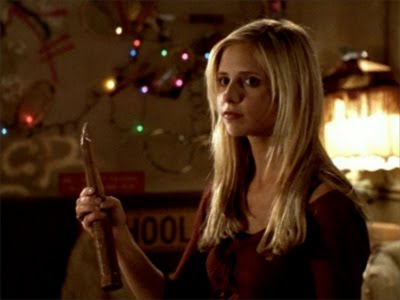On March 10th 1997, Buffy the Vampire Slayer, the cult fantasy drama created by Joss Whedon and starring Sarah Michelle Gellar, debuted. Despite being over two decades old, the series is still as influential as ever. It ran for seven years between 1997 to 2003. I was born the year after Buffy premiered, so I didn’t discover the series until my teens. Even though I’m a generation removed from the show’s original viewers, it still impacted my adolescence.
The show’s protagonist is Buffy Summers, a sixteen-year-old girl living in the fictional town of Sunnydale, California. Buffy is blonde, pretty, petite, and popular. She also happens to be the latest in a long line of all female supernatural fighters, known as “slayers,” who are chosen to fight against vampires and other monsters and are given supernatural strength and reflexes. At the start of the series, Buffy is rather reluctant to be the Chosen One; she wants to live a normal life such as going to school, shopping, hanging out with her friends, and dating. But she rises to her calling, protecting Sunnydale from vampires and the other “monster of the week” – she also saves the world once or twice. Buffy the Vampire Slayer cleverly merges the supernatural, horror, comedy, romance, and action with everyday teenage drama. The character of Buffy was created to subvert one of the most prominent tropes in the horror genre, the hyper-feminine blonde archetype. She is unapologetically feminine, she adores fashion, make-up, and shopping, and wants to be a cheerleader. Defeating monsters and demons with great hair, cute clothes, and a witty comeback was not something typically seen on TV. In an era where the media seemed to always portray women as either the damsel in distress or a victim, Buffy the Vampire Slayer showed a generation of young women that they can conquer any demon whether they are real or internal and continues to do so.
The main cast includes a wide range of strong female characters in addition to Buffy; shy, bookish Willow, mean yet popular Cordelia, Buffy’s compassionate mother Joyce, and Darla the selfish, evil vampire. From the first episode, Buffy shows us that there is no one way to be a woman, you can be smart and sexy, brave and brainy, fierce and feminine; nothing is mutually exclusive for the girls and women of Sunnydale. Throughout the seven year run of the series, these girls were complex characters who grew and developed into strong women, although they still had their faults to overcome. Buffy dealt with issues that not many other shows would tackle, and did so in ways that made the topics accessible for the target teenage audience though hiding the pains of adolescence, heartbreak, addiction, abuse, loss and misogyny behind a supernatural façade. At the beginning of the series, when the main characters are sixteen, the world is very black and white, with a clear distinction between good and evil. As the series progresses, and the characters grow up and enter the adult world, the protagonists’ goals and morals becomes increasingly grey, with the lines blurring between what makes a “goodie” and a “baddie.”
The series has been criticised for being heteronormative and its lack in racial diversity, but Buffy the Vampire Slayer is a strong feminist television series and a timeless cult classic, that will be enjoyed by its teen girl demographic for generations to come.
-Lucy Mullins
Junior Girl
Girl Museum Inc.

